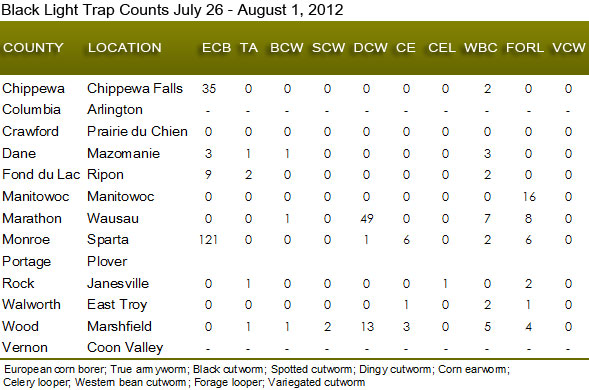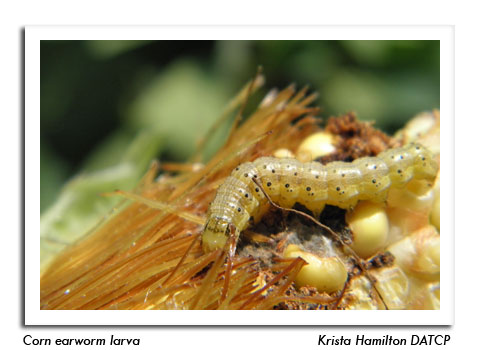
 |
|
|
Corn
Volume 57 Number 16 Date 08/02/2012 CORN ROOTWORM - The annual beetle survey continued during the last reporting period. Preliminary results from the south-central and central areas show a decrease in populations as compared to 2011. Although localized fields in Columbia, Dodge, Green Lake and Waupaca counties contained very high adult populations in the range of 4.0 or more beetles per plant, most sites had non-economic counts of less than 0.5 per plant. The average is 1.0 per plant in the south-central district, 0.5 per plant in the central district, 0.4 per plant in the northwest district and 0.3 in the north-central district. A count of 0.75 or more beetles per plant signals the potential for severe root feeding damage to non-Bt, continuous corn next season. Economic populations were found in 20 of the 99 (20%) fields surveyed as of August 1. CORN EARWORM - The July migration has resulted in light infestations across the state. Larvae ranging from ¾ -1½ inches were observed in Buffalo, Dane, Eau Claire, Trempealeau and Waushara counties in the past week. The moth flight slowed this week at some monitoring locations and increased at others, suggesting that sweet corn producers should continue to check fields regularly for this pest as long as moths are appearing in pheromone traps and green silks are present. Counts during the period of July 26-August 1 were: Aztalan 56, Bloomington 0, Chippewa Falls 6, Columbus 29, Hancock 50, Janesville 0, Manitowoc 4, Marshfield 0, Oregon 20, Ripona 67, Riponb 136, Sun Prairie 36, Wausau 0 and Westport 52. EUROPEAN CORN BORER - Second generation larvae are appearing in the ear tips of corn. Surveyed fields in the central and west-central counties had 2-36% of the ears infested with 1-2 larvae, which varied from newly hatched to third instar. Chemical control is no longer of value in such fields. The treatment window for second generation larvae has closed near Beloit, Madison, La Crosse and Sullivan, and remains open only a few more days in the southeast and central districts. Controls directed against the summer generation must be applied during the period after egg hatch and before larvae bore into the stalks, prior to the accumulation of 2,100 degree days. JAPANESE BEETLE - Damage to silks is apparent in individual corn fields throughout the state, particularly in the south-central and northwest areas. Japanese beetles are a common problem again this season and are likely to remain so for a few more weeks. Large numbers were observed in corn in Chippewa, Dane, Dodge and Eau Claire counties in the past week and treatment may have been justified in a few instances. Control is suggested for infestations of three beetles per ear when corn silks have been pruned to ½ inch and pollination is less than 50% complete. --Krista Hamilton, DATCP Entomologist 



|
|
|